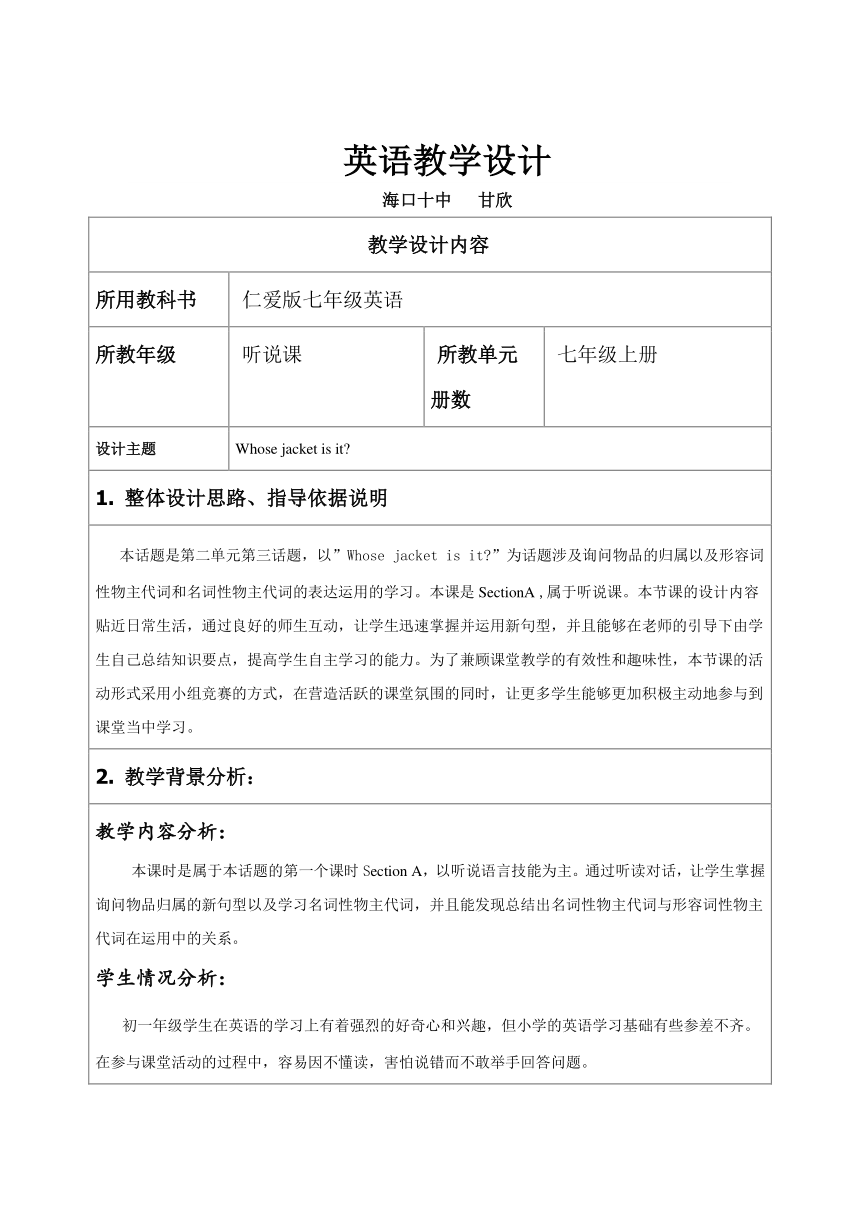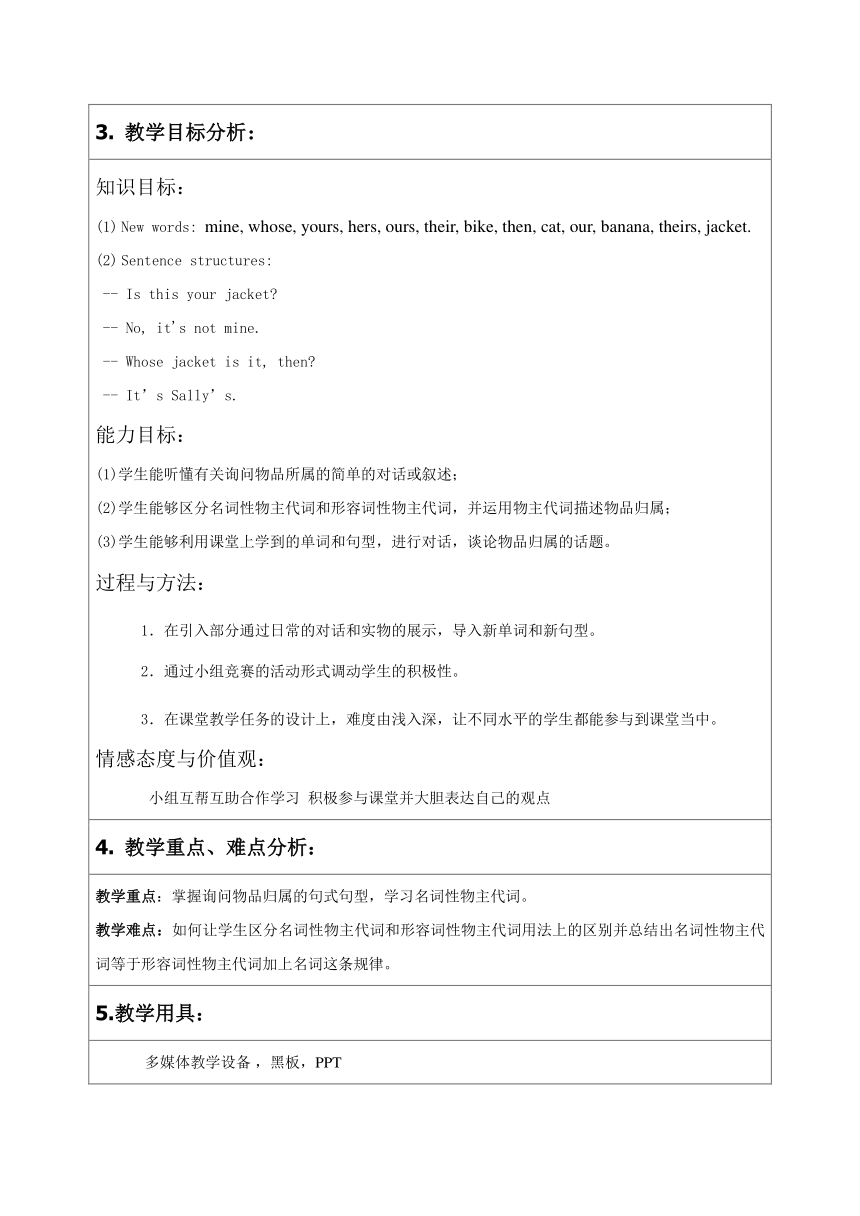海口市教学设计一等奖仁爱版七年级英语上Unit 2 Looking DifferentTopic 3 Whose jacket is it Section A 表格式教学设计
文档属性
| 名称 | 海口市教学设计一等奖仁爱版七年级英语上Unit 2 Looking DifferentTopic 3 Whose jacket is it Section A 表格式教学设计 |  | |
| 格式 | zip | ||
| 文件大小 | 18.6KB | ||
| 资源类型 | 教案 | ||
| 版本资源 | 仁爱科普版 | ||
| 科目 | 英语 | ||
| 更新时间 | 2016-04-15 11:25:01 | ||
图片预览



文档简介
英语教学设计
海口十中 甘欣
教学设计内容
所用教科书 仁爱版七年级英语
所教年级 听说课 所教单元册数 七年级上册
设计主题 Whose jacket is it
1. 整体设计思路、指导依据说明
本话题是第二单元第三话题,以”Whose jacket is it ”为话题涉及询问物品的归属以及形容词性物主代词和名词性物主代词的表达运用的学习。本课是SectionA ,属于听说课。本节课的设计内容贴近日常生活,通过良好的师生互动,让学生迅速掌握并运用新句型,并且能够在老师的引导下由学生自己总结知识要点,提高学生自主学习的能力。为了兼顾课堂教学的有效性和趣味性,本节课的活动形式采用小组竞赛的方式,在营造活跃的课堂氛围的同时,让更多学生能够更加积极主动地参与到课堂当中学习。
2. 教学背景分析:
教学内容分析: 本课时是属于本话题的第一个课时Section A,以听说语言技能为主。通过听读对话,让学生掌握询问物品归属的新句型以及学习名词性物主代词,并且能发现总结出名词性物主代词与形容词性物主代词在运用中的关系。学生情况分析: 初一年级学生在英语的学习上有着强烈的好奇心和兴趣,但小学的英语学习基础有些参差不齐。在参与课堂活动的过程中,容易因不懂读,害怕说错而不敢举手回答问题。
3. 教学目标分析:
知识目标:New words: mine, whose, yours, hers, ours, their, bike, then, cat, our, banana, theirs, jacket.Sentence structures: -- Is this your jacket -- No, it's not mine.-- Whose jacket is it, then -- It’s Sally’s.能力目标:学生能听懂有关询问物品所属的简单的对话或叙述;学生能够区分名词性物主代词和形容词性物主代词,并运用物主代词描述物品归属;(3)学生能够利用课堂上学到的单词和句型,进行对话,谈论物品归属的话题。过程与方法:1.在引入部分通过日常的对话和实物的展示,导入新单词和新句型。2.通过小组竞赛的活动形式调动学生的积极性。3.在课堂教学任务的设计上,难度由浅入深,让不同水平的学生都能参与到课堂当中。情感态度与价值观:小组互帮互助合作学习 积极参与课堂并大胆表达自己的观点
4. 教学重点、难点分析:
教学重点:掌握询问物品归属的句式句型,学习名词性物主代词。教学难点:如何让学生区分名词性物主代词和形容词性物主代词用法上的区别并总结出名词性物主代词等于形容词性物主代词加上名词这条规律。
5.教学用具:
多媒体教学设备 ,黑板,PPT
6.教学过程设计:
教学步骤 设计意图
步骤一:Warming-up1. Sing the song together: Hello! How are you 歌曲能够活跃课堂气氛,让学生迅速进入英语课堂学习的状态。
步骤二:Greeting and lead in.T: Ok, it’s time to the class. Good morning, everyone!Ss: Good morning, Miss Gan.T: How are you today Ss: Fine, thanks. And you T: I’m OK. But the weather of today is a little hot. Do you feel hot now Ss: Yes, I do.T: Today is hot, so we all wears short T-shirt. So look at this T-shirt, do you know whose T-shirt it is Ss: It’s your T-shirt.T: Yes, this is my T-shirt. This is mine. 通过日常的问候,增进师生之间的交流互动,并且导入询问物体归属的新句型和名词性物主代词。
步骤三:Pre-listening1. Show the pictures and learn new words and sentences.T: Look at this picture, what is this Ss: It’s a book.T: Is that book yours Ss: No, it is not my book.T: Whose book is it Ss: It’s Jane’s book.T: Bingo! So that is her book, that is hers. Read after me, hers.Ss: Hers.T: Ok, what are those Ss: They are shoes.T: Yes! Whose shoes are those Ss: They are their shoes.T: Good! They are their shoes. We can also say they are theirs. Read after me, their, theirs.Ss: Their, theirs.T: Good! Boys and girls, look around this classroom. Whose classroom is this Ss: This is our classroom.T: Yes! This is our classroom. This is ours. Read after me, our, ours.Ss: Our, ours.T: Look! What’s this Ss: It’s a cat.T: Yes, read after me, cat, C-A-T, cat.Ss: Cat, C-A-T, cat.T: Do you like cat Ss: Yes, I do.T: I like cat very much. But this is not my cat. Whose cat is it Ss: It’s her cat.T: Good! We can also say it’s hers. Next, what’s this Ss: It’s a bike.T: Yes! Read after me, bike, B-I-K-E, bike.Ss: Bike, B-I-K-E, bike.T: Whose bike is this Is it yours Ss: No, it's his bike.T: Bingo! It’s his bike. It’s his. OK, what are those Ss: They are bananas.T: Yes, whose bananas are those Ss: They are their bananas. T: Right. We can also say they are theirs. Read after me, banana, B-A-N-A-N-A, banana.Ss: Banana, B-A-N-A-N-A, banana.T: Well down! Now let’s read the new words together.T: Now who can read the words Who wants to have a try (Read the words with the phonetic symbol and meanings.)Ss: ………T: Very good!2. Finish 2 and find the rules between nominal possessvive pronoun and adjectival possessive pronoun. T: Now open your textbook, turn to page plete the sentences as quick as possible. I will give you three minutes to finish it. Ss: (Do the practice of 2)T: OK, time’s up. Have you finished Let’s check the answer. Any volunteer Ss: ……T: Excellent! Now look at these sentences, can you find the rule Ss: …….T: Well done! 通过图片展示和互动引导的方式,学习新单词并且重复询问物品归属的句型“Whose … is this /are those ”。完成练习2,并且摘取其中的关键单词展示,引导学生发现总结关于名词性物主代词和名词性物主代词的规律: 名词性物主代词=形容词性物主代词+名词(在总结规律部分,为了便于学生理解,可以用中文进行表达)。同时,为1a的听力做好准备。
步骤四:While-listening1. Show the picture of 1a and guess what they are talking about.2. Listen to 1a and answer the question Whose jacket is it 3. Listen to 1a again and fill in the blanks and then check the answers.4. Listen to the conversation of 1a following the tape. 针对1a的听力,设计的任务包括:回答问题,完成填空和跟读对话。难度由浅至深,并通过跟读的方式去模仿对话的语音语调。
步骤五:Post-listeningThe whole class read the conversation of 1a together.Practice the conversation of 1a by role play.Show the pictures of 1b and analyze the things in the hands of people.Listen to 1b twice and number the pictures in correct order and then check the answer. 通过角色扮演的方式操练1a的 对话和1b的听力练习,以确认学生对询问物品归属的句型以及名词性物主代词的掌握情况。
步骤六:ProjectLet’s play a game.1. Fill in the table about nominal possessvive pronoun and adjectival possessive pronoun. 2. Change the sentences.3. Make a dialogue with the hints. 采用不同得分的方式,以及不同难度的任务巩固本节课的知识重点和难点。
步骤七:Summary and homeworkLet the students summarize what they have learnt in this lesson.HomeworkRecite the conversation of 1a.Copy the new words of SetionA .Make a new dialogue by imitating 1a. 由学生来总结本节课所学到的内容,对知识点进行梳理。
7. 教学评价设计:
评价内容: 本节课学生的表现十分积极活跃,大多数学生都能参与到课堂活动当中来。尤其是在学习新单词和角色扮演操练对话以及最后的游戏部分表现出色。但在总结名词性物主代词和形容词性物主代词的规律的部分,还需要老师更细心的引导。评价方法: 主要采用1. 鼓励性评价,评价语言以学生参与英语教学活动时所表现出来的兴趣,态度和交流能力为主要依据,以 good / well done/ very good/ excellent等给学生加以评价;2. 竞争性评价,以小组打分的形式进行评价。
板书设计:
Unit 2 Looking DifferentTopic 3 Whose jacket is it Section ANew words:mine /ma n/我的 whose /hu z/谁的 1. -- Is this your jacket yours/j z /你的 then / en/ 那么 -- No, it’s not mine.hers /h z/她的 cat/k t/ 猫 2. – Whose jacket is it our / ours /a //a z/ 我们的 --It’s Sally’s.their / theirs / e // e z/ 他们的bike /ba k/ 自行车 banana/b ‘nɑ n / 香蕉
海口十中 甘欣
教学设计内容
所用教科书 仁爱版七年级英语
所教年级 听说课 所教单元册数 七年级上册
设计主题 Whose jacket is it
1. 整体设计思路、指导依据说明
本话题是第二单元第三话题,以”Whose jacket is it ”为话题涉及询问物品的归属以及形容词性物主代词和名词性物主代词的表达运用的学习。本课是SectionA ,属于听说课。本节课的设计内容贴近日常生活,通过良好的师生互动,让学生迅速掌握并运用新句型,并且能够在老师的引导下由学生自己总结知识要点,提高学生自主学习的能力。为了兼顾课堂教学的有效性和趣味性,本节课的活动形式采用小组竞赛的方式,在营造活跃的课堂氛围的同时,让更多学生能够更加积极主动地参与到课堂当中学习。
2. 教学背景分析:
教学内容分析: 本课时是属于本话题的第一个课时Section A,以听说语言技能为主。通过听读对话,让学生掌握询问物品归属的新句型以及学习名词性物主代词,并且能发现总结出名词性物主代词与形容词性物主代词在运用中的关系。学生情况分析: 初一年级学生在英语的学习上有着强烈的好奇心和兴趣,但小学的英语学习基础有些参差不齐。在参与课堂活动的过程中,容易因不懂读,害怕说错而不敢举手回答问题。
3. 教学目标分析:
知识目标:New words: mine, whose, yours, hers, ours, their, bike, then, cat, our, banana, theirs, jacket.Sentence structures: -- Is this your jacket -- No, it's not mine.-- Whose jacket is it, then -- It’s Sally’s.能力目标:学生能听懂有关询问物品所属的简单的对话或叙述;学生能够区分名词性物主代词和形容词性物主代词,并运用物主代词描述物品归属;(3)学生能够利用课堂上学到的单词和句型,进行对话,谈论物品归属的话题。过程与方法:1.在引入部分通过日常的对话和实物的展示,导入新单词和新句型。2.通过小组竞赛的活动形式调动学生的积极性。3.在课堂教学任务的设计上,难度由浅入深,让不同水平的学生都能参与到课堂当中。情感态度与价值观:小组互帮互助合作学习 积极参与课堂并大胆表达自己的观点
4. 教学重点、难点分析:
教学重点:掌握询问物品归属的句式句型,学习名词性物主代词。教学难点:如何让学生区分名词性物主代词和形容词性物主代词用法上的区别并总结出名词性物主代词等于形容词性物主代词加上名词这条规律。
5.教学用具:
多媒体教学设备 ,黑板,PPT
6.教学过程设计:
教学步骤 设计意图
步骤一:Warming-up1. Sing the song together: Hello! How are you 歌曲能够活跃课堂气氛,让学生迅速进入英语课堂学习的状态。
步骤二:Greeting and lead in.T: Ok, it’s time to the class. Good morning, everyone!Ss: Good morning, Miss Gan.T: How are you today Ss: Fine, thanks. And you T: I’m OK. But the weather of today is a little hot. Do you feel hot now Ss: Yes, I do.T: Today is hot, so we all wears short T-shirt. So look at this T-shirt, do you know whose T-shirt it is Ss: It’s your T-shirt.T: Yes, this is my T-shirt. This is mine. 通过日常的问候,增进师生之间的交流互动,并且导入询问物体归属的新句型和名词性物主代词。
步骤三:Pre-listening1. Show the pictures and learn new words and sentences.T: Look at this picture, what is this Ss: It’s a book.T: Is that book yours Ss: No, it is not my book.T: Whose book is it Ss: It’s Jane’s book.T: Bingo! So that is her book, that is hers. Read after me, hers.Ss: Hers.T: Ok, what are those Ss: They are shoes.T: Yes! Whose shoes are those Ss: They are their shoes.T: Good! They are their shoes. We can also say they are theirs. Read after me, their, theirs.Ss: Their, theirs.T: Good! Boys and girls, look around this classroom. Whose classroom is this Ss: This is our classroom.T: Yes! This is our classroom. This is ours. Read after me, our, ours.Ss: Our, ours.T: Look! What’s this Ss: It’s a cat.T: Yes, read after me, cat, C-A-T, cat.Ss: Cat, C-A-T, cat.T: Do you like cat Ss: Yes, I do.T: I like cat very much. But this is not my cat. Whose cat is it Ss: It’s her cat.T: Good! We can also say it’s hers. Next, what’s this Ss: It’s a bike.T: Yes! Read after me, bike, B-I-K-E, bike.Ss: Bike, B-I-K-E, bike.T: Whose bike is this Is it yours Ss: No, it's his bike.T: Bingo! It’s his bike. It’s his. OK, what are those Ss: They are bananas.T: Yes, whose bananas are those Ss: They are their bananas. T: Right. We can also say they are theirs. Read after me, banana, B-A-N-A-N-A, banana.Ss: Banana, B-A-N-A-N-A, banana.T: Well down! Now let’s read the new words together.T: Now who can read the words Who wants to have a try (Read the words with the phonetic symbol and meanings.)Ss: ………T: Very good!2. Finish 2 and find the rules between nominal possessvive pronoun and adjectival possessive pronoun. T: Now open your textbook, turn to page plete the sentences as quick as possible. I will give you three minutes to finish it. Ss: (Do the practice of 2)T: OK, time’s up. Have you finished Let’s check the answer. Any volunteer Ss: ……T: Excellent! Now look at these sentences, can you find the rule Ss: …….T: Well done! 通过图片展示和互动引导的方式,学习新单词并且重复询问物品归属的句型“Whose … is this /are those ”。完成练习2,并且摘取其中的关键单词展示,引导学生发现总结关于名词性物主代词和名词性物主代词的规律: 名词性物主代词=形容词性物主代词+名词(在总结规律部分,为了便于学生理解,可以用中文进行表达)。同时,为1a的听力做好准备。
步骤四:While-listening1. Show the picture of 1a and guess what they are talking about.2. Listen to 1a and answer the question Whose jacket is it 3. Listen to 1a again and fill in the blanks and then check the answers.4. Listen to the conversation of 1a following the tape. 针对1a的听力,设计的任务包括:回答问题,完成填空和跟读对话。难度由浅至深,并通过跟读的方式去模仿对话的语音语调。
步骤五:Post-listeningThe whole class read the conversation of 1a together.Practice the conversation of 1a by role play.Show the pictures of 1b and analyze the things in the hands of people.Listen to 1b twice and number the pictures in correct order and then check the answer. 通过角色扮演的方式操练1a的 对话和1b的听力练习,以确认学生对询问物品归属的句型以及名词性物主代词的掌握情况。
步骤六:ProjectLet’s play a game.1. Fill in the table about nominal possessvive pronoun and adjectival possessive pronoun. 2. Change the sentences.3. Make a dialogue with the hints. 采用不同得分的方式,以及不同难度的任务巩固本节课的知识重点和难点。
步骤七:Summary and homeworkLet the students summarize what they have learnt in this lesson.HomeworkRecite the conversation of 1a.Copy the new words of SetionA .Make a new dialogue by imitating 1a. 由学生来总结本节课所学到的内容,对知识点进行梳理。
7. 教学评价设计:
评价内容: 本节课学生的表现十分积极活跃,大多数学生都能参与到课堂活动当中来。尤其是在学习新单词和角色扮演操练对话以及最后的游戏部分表现出色。但在总结名词性物主代词和形容词性物主代词的规律的部分,还需要老师更细心的引导。评价方法: 主要采用1. 鼓励性评价,评价语言以学生参与英语教学活动时所表现出来的兴趣,态度和交流能力为主要依据,以 good / well done/ very good/ excellent等给学生加以评价;2. 竞争性评价,以小组打分的形式进行评价。
板书设计:
Unit 2 Looking DifferentTopic 3 Whose jacket is it Section ANew words:mine /ma n/我的 whose /hu z/谁的 1. -- Is this your jacket yours/j z /你的 then / en/ 那么 -- No, it’s not mine.hers /h z/她的 cat/k t/ 猫 2. – Whose jacket is it our / ours /a //a z/ 我们的 --It’s Sally’s.their / theirs / e // e z/ 他们的bike /ba k/ 自行车 banana/b ‘nɑ n / 香蕉
同课章节目录
- Unit 1 Making new friends
- Topic 1 Welcome to China!
- Topic 2 Where are you from?
- Topic 3 How old are you?
- Unit 2 Looking different
- Topic 1 I have a small nose
- Topic 2 What does she look like?
- Topic 3 Whose jacket is this?
- Unit 3 Getting togethe
- Topic 1 Does he speak Chinese?
- Topic 2 What do your parents do?
- Topic 3 What would you like to drink?
- Unit 4 Having fun
- Topic 1 What can I do for you?
- Topic 2 Would you like to cook with us?
- Topic 3 What time is it now?
